

0.9.3-6.2build1 : “libdecodeqr” package. Template Matching — OpenCV 2. Goal In this tutorial you will learn how to: Use the OpenCV function matchTemplate to search for matches between an image patch and an input imageUse the OpenCV function minMaxLoc to find the maximum and minimum values (as well as their positions) in a given array.
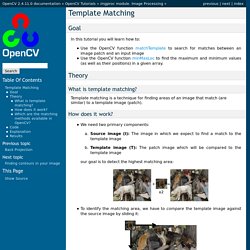
Theory What is template matching? Template matching is a technique for finding areas of an image that match (are similar) to a template image (patch). How does it work? We need two primary components:Source image (I): The image in which we expect to find a match to the template imageTemplate image (T): The patch image which will be compared to the template imageour goal is to detect the highest matching area: To identify the matching area, we have to compare the template image against the source image by sliding it: By sliding, we mean moving the patch one pixel at a time (left to right, up to down). The image above is the result R of sliding the patch with a metric TM_CCORR_NORMED. C++ - How to detect the Sun from the space sky in OpenCv. Scanning QR Codes. T hese days, you can see QR codes almost everywhere. You see them at stores, on products, on screens. So one day, I was curious how the gears are put together to read QR codes.
I ended up reading the ISO/IEC 18004 standard. It’s a very robust and detailed documentation on how QR codes are supposed to work. I’ve put up a link in the downloads section below if you’re interested. This is a multipart series – we’ll be creating a QR code reader from scratch in OpenCV. Anatomy of a QR code A QR code is made up of four main parts: Finder patterns: These are the big black/white/black squares on the three corners on the QR code. Libqrencode. Latest release qrencode-3.4.3.tar.gz (sha1sum) / qrencode-3.4.3.tar.bz2 (sha1sum) (2013.8.12) Development edition You can find the development edition at github.
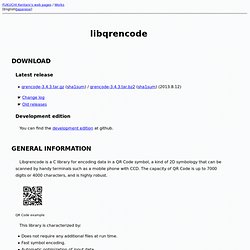
Libqrencode is a C library for encoding data in a QR Code symbol, a kind of 2D symbology that can be scanned by handy terminals such as a mobile phone with CCD. The capacity of QR Code is up to 7000 digits or 4000 characters, and is highly robust. Sony Makes Their Own Holodeck (with Projection Mapping) December 1st, 2011 by Paul Strauss Using a variety of visual tricks, including projection mapping, props, and motion-tracking, Sony managed to create some of the most mind-blowing visual illusions I’ve ever seen on video, bringing to life a sort of virtual “holodeck” for us to feast our eyes on.

The series of three spots was produced on behalf of Sony Europe by Studio Output and Marshmallow Laser Feast to promote the immersiveness of movies rented or purchased from the PlayStation Store, and they definitely get the point across with these spectacular short clips. Incredibly, all three clips were shot in real-time, with zero edits or post-production. Everything you see was an optical effect seen through the lens of the camera.
OpenCV: Decoding QR Codes using libdecoderqr. Libdecodeqr.
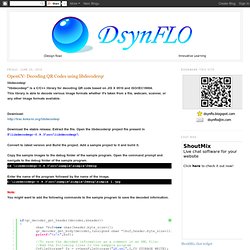
OpenCV: How to keystone an image. Accurate Image Retrieval Based On Compact Composite Descriptors ... Free Development software downloads. Image Retrieval Based On Fuzzy Color Histogram Processing.
LIRe Demo. SemanticMetadata.net. An Open Source Java Content Based Image Retrieval Library The LIRE (Lucene Image REtrieval) library provides a simple way to retrieve images and photos based on their color and texture characteristics.
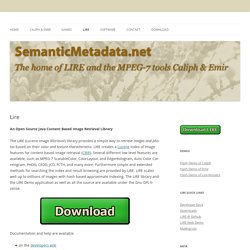
LIRE creates a Lucene index of image features for content based image retrieval (CBIR). Several different low level features are available, such as MPEG-7 ScalableColor, ColorLayout, and EdgeHistogram, Auto Color Correlogram, PHOG, CEDD, JCD, FCTH, and many more. Furthermore simple and extended methods for searching the index and result browsing are provided by LIRE. LIRE scales well up to millions of images with hash based approximate indexing. Documentation and help are available Please drop me a line on the mailing list if you use LIRE in your project.
If you like this work and you want to support the development of Lire, consider to donate to the project. Consulting & Services You plan to work with LIRE and you are stuck? Which ones are the right features for me?
Tracking Benchmarks. Histogram Comparison — OpenCV 2. Goal In this tutorial you will learn how to: Use the function compareHist to get a numerical parameter that express how well two histograms match with each other.Use different metrics to compare histograms Theory To compare two histograms ( and ), first we have to choose a metric () to express how well both histograms match.OpenCV implements the function compareHist to perform a comparison.
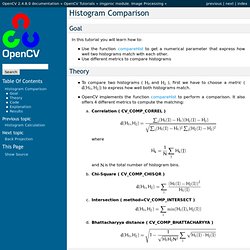
It also offers 4 different metrics to compute the matching:Correlation ( CV_COMP_CORREL ) whereand is the total number of histogram bins.Chi-Square ( CV_COMP_CHISQR ) Intersection ( method=CV_COMP_INTERSECT )Bhattacharyya distance ( CV_COMP_BHATTACHARYYA ) Code What does this program do? Explanation. Fast Approximate Nearest Neighbor Search — OpenCV 2. This section documents OpenCV’s interface to the FLANN library.
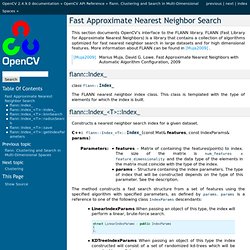
FLANN (Fast Library for Approximate Nearest Neighbors) is a library that contains a collection of algorithms optimized for fast nearest neighbor search in large datasets and for high dimensional features. More information about FLANN can be found in [Muja2009] . flann::Index_ class flann::Index_ The FLANN nearest neighbor index class. Flann::Index_<T>::Index_ The PASCAL Visual Object Classes Challenge 2010 (VOC2010) News 09-Mar-11: Test data can now be downloaded from the PASCAL VOC Evaluation Server.
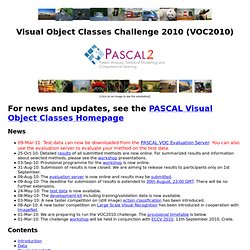
You can also use the evaluation server to evaluate your method on the test data. 25-Oct-10: Detailed results of all submitted methods are now online. For summarized results and information about selected methods, please see the workshop presentations. 03-Sep-10: Provisional programme for the workshop is now online. 31-Aug-10: Submission of results is now closed. We are aiming to release results to participants only on 1st September. 09-Aug-10: The evaluation server is now online and results may be submitted. 09-Aug-10: The deadline for submission of results is extended to 30th August, 23:00 GMT. Contents Introduction. Search Results — content-based image retrieval. Content based Image Retrieval . . . by Christian Wolf , 2000 "...
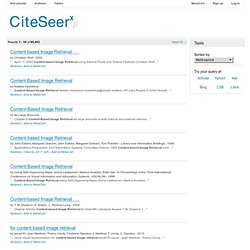
April 17, 2000 Content based Image Retrieval using Interest Points and Texture Features Christian Wolf ... " Hash - OpenCV: Fingerprint Image and Compare Against Database. OpenSURF - The Official Home of the Image Processing Library. The task of finding point correspondences between two images of the same scene or object is an integral part of many machine vision or computer vision systems.
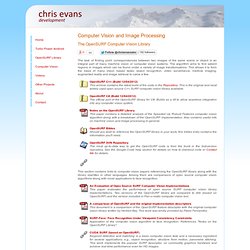
The algorithm aims to find salient regions in images which can be found under a variety of image transformations. This allows it to form the basis of many vision based tasks; object recognition, video surveillance, medical imaging, augmented reality and image retrieval to name a few. OpenSURF C# (Build 12/04/2012)The official port of the OpenSURF library for C#. Builds as a dll to allow seamless integration into any computer vision system.
Notes on the OpenSURF LibraryThis paper contains a detailed analysis of the Speeded Up Robust Features computer vision algorithm along with a breakdown of the OpenSURF implementation. OpenSURF BibtexShould you wish to reference the OpenSURF library in your work, this bibtex entry contains the information you'll need. Please also link to this page if you have found OpenSURF useful! Find-object - Simple Qt interface to try OpenCV implementations of SIFT, SURF, FAST, BRIEF and other feature detectors and descriptors. Www.cs.washington.edu/research/VACE/ObjectRecognition/ocr4cbir.pdf. LIRe: Lucene image retrieval - An extensible java CBIR library. Download Content Based Image Retrieval Software: BRISC Image Retrieval System, Lire & Caliph And Emir, FVS: A Content-Based Retrieval Library.